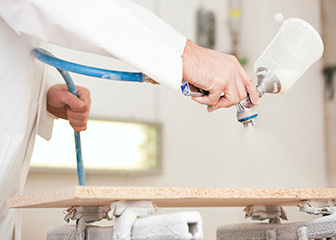Summary
Please enable javascript to play this video.
| Quick Facts: Painting and Coating Workers | |
|---|---|
|
$47,390 per year
$22.79 per hour |
|
| See How to Become One | |
| None | |
| Moderate-term on-the-job training | |
| 174,300 | |
| 1% (Slower than average) | |
| 1,300 | |
What Painting and Coating Workers Do
Painting and coating workers apply finishes, often using machines, to a range of products.
Work Environment
Most painting and coating workers are employed full time. They frequently stand for long periods in specially ventilated areas.
How to Become a Painting and Coating Worker
Painting and coating workers typically need a high school diploma or equivalent to enter the occupation. New workers usually train on the job for several months.
Pay
The median annual wage for coating, painting, and spraying machine setters, operators, and tenders was $47,590 in May 2024.
The median annual wage for painting, coating, and decorating workers was $40,860 in May 2024.
Job Outlook
Overall employment of painting and coating workers is projected to grow 1 percent from 2024 to 2034, slower than the average for all occupations.
Despite limited employment growth, about 16,700 openings for painting and coating workers are projected each year, on average, over the decade. Most of those openings are expected to result from the need to replace workers who transfer to different occupations or exit the labor force, such as to retire.
State & Area Data
Explore resources for employment and wages by state and area for painting and coating workers.
Similar Occupations
Compare the job duties, education, job growth, and pay of painting and coating workers with similar occupations.
More Information, Including Links to O*NET
Learn more about painting and coating workers by visiting additional resources, including O*NET, a source on key characteristics of workers and occupations.
 United States Department of Labor
United States Department of Labor





